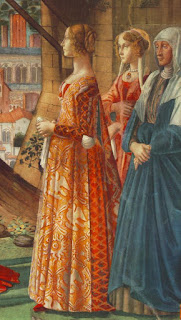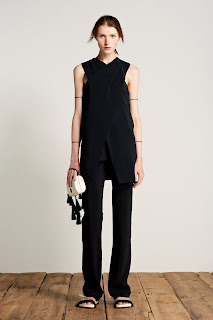Every now and again, there comes along a pattern that catches fire and takes everyone's fancy. This is one of them.
Seemingly a very simple shift knit dress, it's made unique by those newfangled, off-to-starboard-off-to-port angled panels over the front and (hooray!) back. Like the Bluenose ploughing through a sou'easter with handsome Captain Angus Walters at her helm.
With this one, Marcy Tilton hit it way, way out of the park.
Once again I applaud the great resource that is Pattern Review. When I started to think of making this dress, I took a nice long look at the versions already posted there - at last count, 52 reviews. All made within two years of the pattern's release. They allowed me to look at very many versions and ponder at my leisure what it was that I liked, and why, and how, I liked it. Quite the luxury.
I decided what I wanted:
- knee length: not mid-thigh nor mid-calf
- all five panels, on a knee length dress; the pattern uses four panels on an above-the-knee length and five on a midi
- all shingle stripes, including the bottom one, oriented (more or less) horizontally
- each panel ending on a dark stripe
- long sleeves, cut so the stripes run vertically
- widened shoulders on the dress
Taking my desire to fit all five panels into my shorter than standard shoulder to knee height, I began by shortening the underdress pattern piece by about 2 cm in the middle of each "shingle", and then shortening each shingle to match. I then asked my fashion designer mom - she's a wicked seamstress with a mouthful of pins! - to pin-fit the sides and to take out a horizontal fisheye dart just above my behind to remove any back waist puddling.
Getting each pair of front and back panels to match exactly seemed to take forever. This seemingly easy peasy quick little frock is anything but. Everything seemed to take forever: like ensuring all panels were symmetrically spaced; finishing/hemming and aligning each front and back panel pair - and then, matching all these damned little stripes along the side seams. Agony and arrrgh! I pinned said seams till they looked like line-dancing hedgehogs; machine basted, checked, ripped, repinned, rebasted, re-checked, re-ripped.... and repinned...... and again.... and again.... There were sections that I must've re-done four or five times. The human eye is capable of noticing a mis-match of much less than a millimeter - so once I decided that these side seams were going to be matched, dammit, it was a verrrry long afternoon of following through, spitting pins all the way.
Hokay.
The best part, though? He heh. I got a long sleeved tee out of the remnant.
Using the same pattern, and the scraps, I whipped up this tee before the rest of my family were up this morning - hey, the pattern and all its makings were already on my table!
My son said, "you look verrhy Frrhench!"
My hubs added dryly, "very French Apache".
Zut alors! Vraiement?!
I was really sick to death of being all couture by this point, so after the initial matching of the stripes at the side seams, I let them do their own thing.
The sleeves are pieced. Just because. For fun.
Love the dissonance of the sleeves. The upper left one is cut on the bias.
I raised the front and back necklines 1/4", and used a dark stripe for the binding.
Really takes me back to my teenage sailing days. Need - more - stripey - tees.
Here's a modern version of a French Apache dance. Warning for the sensitive - it's very, very politically incorrect. But very good.

















































